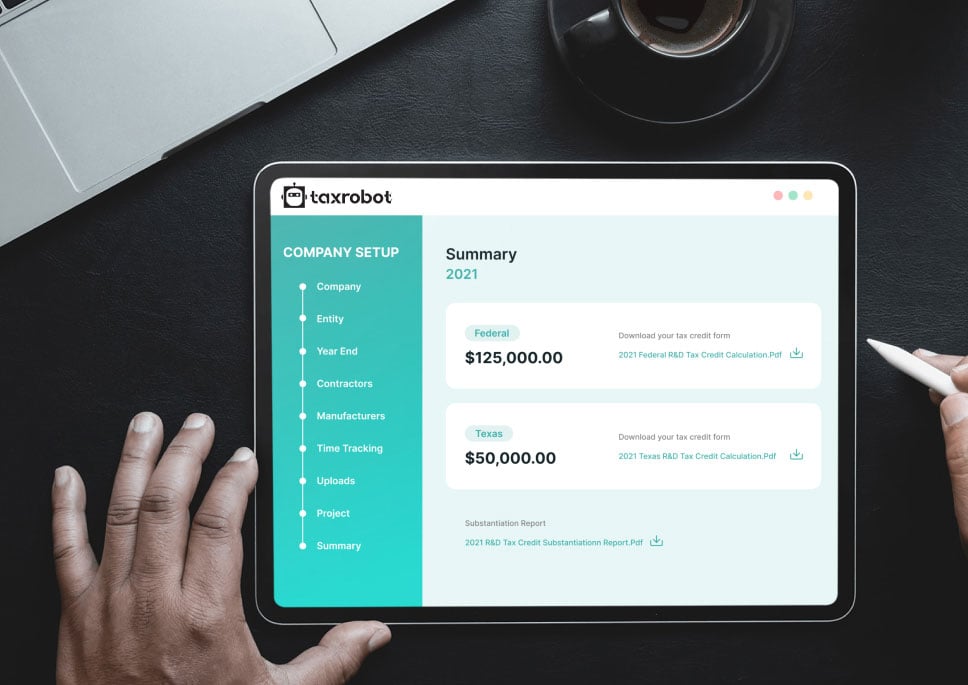Arkansas R&D Credit
The Bear State is the best state for business! As a business leader, you can qualify for various research and development (R&D) credits. The key is understanding what each credit means and how you can start applying for them today. Here’s your brief Arkansas R&D credit guide.
Maximize your State Credits today!
Put the R&D tax credit process on autopilot.
Trusted By:








Arkansas R&D Credit
Discover your eligibility for Arkansas R&D tax credits and supercharge your enterprise.
Arkansas Research and Development Credits
Each Arkansas R&D credit has a unique application process, so review the credits carefully with a trained accountant and tax lawyer. You can carry any of these credits forward for nine years and offset 100% of your tax liability, though you cannot receive refunds from the government.
In-House Research and Development
You can apply for this credit if you qualify for federal R&D credits. You can receive 20% of research expenses that exceed the average amount of money you spent over the last five years. For example, if you spent $1 million in 2023 and an average of $800,000 a year from 2018 to 2022, you can claim a credit of $40,000.
Qualifying in-house research expenses include researcher wages and supply costs. You cannot claim credits for land expenses, overhead costs, and office supplies.
A Targeted Business’s In-House Research
Arkansas has many categories of targeted businesses, including companies in nanotechnology, electronics manufacturing, and software development. Your business must also be a startup less than five years old and pay your employees at least 150% of the Arkansas statewide or county average hourly wage. If your company is a targeted business, you can claim income tax credits of up to 33% for research and development expenses.
You must provide a project plan explaining your research project’s purpose and how much you spent on it. You can claim credits for a project you are about to implement, though you can only receive credits for up to five years. Once you claim R&D credits, you cannot receive job creation or research credits for the same expenses.
Research and Development in an Area of Strategic Value
An area of strategic value is a field with long-term commercial or economic value to Arkansas. You can claim up to $50,000 yearly on research in your area or 33% of your qualified research expenditures. You can also qualify for this credit if you complete a project from the Arkansas Economic Development Commission (AEDC).
Connect with the AEDC to see if you qualify for this credit. Send them a project plan and detail the research you have done and plan on doing.
University-Based Research
You qualify for this credit when you hire an Arkansas college or university to complete research for you. You can receive up to 33% of your expenditures as credits and receive other R&D credits.
Starting Your Arkansas R&D Credit Application Process
Do not rush filing your tax documents or applying for R&D credits. In addition to your project plan, you should have documents that show how much your employees work and how much you pay them. You should also have reports, data sheets, and other papers with the research you’ve done on it. A business plan isn’t necessary, but it can clarify how your research helps your business in the long run.
The Division of Science and Technology at AEDC determines whether your expenses count as qualified research expenses. Schedule an appointment with an auditor before filing your taxes. Present your documents to them and ask your employees and research consultants to testify about the research and expenses.
Take a sneak peak

- Limited Time Offer
- Simple Onboarding
- Easy to Use
R&D Tax Credits FAQs
The four-part test as outlined in the Internal Revenue Code is used to determine qualified R&D activity.
The Four-Part Test
1). New Or Improved Business Component
Creation of a new product, process, formula, invention, software, or technique; or improving the performance, functionality, quality, or reliability of existing business component.
- Construction of new buildings or renovation of existing buildings
- Invention of a software application
- Manufacturing of a new product or the improvement of the production process for an existing product
- Creation of design documentation
2). Technological In Nature
The activity fundamentally relies on principles of the physical or biological sciences, engineering, or computer science. A taxpayer does not need to obtain information that exceeds, expands or refines the common knowledge of skilled professionals in a particular field.
- Physics (relationship between mass, density and volume; loading as the
result of gravitational attraction) - Engineering (mechanical, electrical, civil, chemical)
- Computer science (theory of computation and design of computational systems)
3). Elimination Of Uncertainty
Uncertainty exists if the information available to the taxpayer does not establish the capability or method for developing or improving the business component, or the appropriate design of the business component.
- The capability of a manufacturer to create a part within the specified tolerances
- The appropriate method of overcoming unsuitable soil conditions during construction
- The appropriate software design to meet quality and volatility requirements
4). Process Of Experimentation
A process designed to evaluate one or more alternatives to achieve a result where the capability or method of achieving that result, or the appropriate design of that result, is uncertain as of the beginning of the taxpayer’s research activities.
- Systematic process of trial and error
- Evaluating alternative means and methods
- Computer modeling or simulation Prototyping Testing
The R&D tax credit is one of the most misunderstood tax incentives available. Considering the myriad of industries and activities that legally qualify for the credit, the term “research and development” is a misnomer. Additionally, the R&D tax credit requires specialized knowledge and technology to identify and calculate the incentive properly.
Companies of various industries are unaware that they are eligible to claim the R&D tax credit. Under the Internal Revenue Code’s definition of R&D, many common activities qualify. You can get tax benefits for industries including software, technology, architecture, engineering, construction, manufacturing, and more.
The R&D tax credit can be claimed for all open tax years. Generally, open tax years include the prior three tax years due to the statute of limitations period. In certain circumstances, the law allows businesses to claim the R&D tax credit for an extended period of time. It is common for companies to amend previous tax years to claim this benefit and reduce the maximum amount of tax liability.
Partnerships and S corporations must file this form to claim the credit. The credit will flow from the Form 6765, to the Schedule K-1, to the Form 3800 on the individual’s tax return. For individuals receiving this credit that have ownership interest in a partnership or S corporation, Form 6765 is not required on the individual return.
Individuals claiming this credit can report the credit directly on Form 3800, General Business Credit if their only source for the credit is a partnership, S corporation, estate, or trust. Otherwise, Form 6765 must be filed with the individual’s tax return (e.g. sole proprietorship).
For tax years prior to 2016, the credit can be used to reduce the taxpayer’s regular tax liability down to the tentative minimum tax. The credit cannot be used to offset alternative minimum tax. Beginning in tax year 2016, eligible small businesses have expanded utilization for the credit. For these eligible small businesses, the regular tax liability can offset alternative minimum tax using the “25/25” rule.
What our customers have to say
I highly recommend TaxRobot to anyone considering an R&D Tax Credit software to complete their analysis.

We decided to switch to TaxRobot… Best decision we’ve ever made. More affordable, and less complicated.

I couldn’t believe how easy it was! In under an hour, we saved enough money to hire a new employee.
